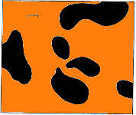Subgaussian Variables and Concentration
Posted: 2017-12-18.
In this post we'll take a look at the definition of subgaussian random variables and see how those are used in measure concentration.
We'll see a couple advantages of the definitions and studying subgaussians:
- The point is that subgaussian variables have "tails" that fall off like Gaussians with exponentially decreasing probability, depending on their subgaussian parameter.
- Basic operations, like scaling by a constant or adding together independent variables, give new subgaussian parameters according to simple formulas.
- The subgaussian tail bounds for these variables are generally very tight, just like Chernoff or Hoeffding bounds.
Basics and Definition
First, you should be familiar with the basics of measure concentration. We have a random variable $Y$ taking values in $\mathbb{R}$. We will assume here that $Y$ has mean zero although one can naturally extend the definitions by subtracting off the mean.
If $Y$ has mean zero, $Y$ is said to be $\sigma^2$-subgaussian if for all $b \in \mathbb{R}$,
\[ \mathbb{E}[e^{bY}] \leq e^{\sigma^2 b^2/2} . \]Fact 1. If $Y$ is $\sigma^2$-subgaussian, then for all $t \geq 0$, \[ \Pr[ Y \geq t ] \leq e^{-t^2 / (2\sigma^2)} \] and \[ \Pr[ Y \leq -t ] \leq e^{-t^2 / (2\sigma^2)} . \]
Proof. By Markov's inequality and the ``Chernoff method'', for all $\theta \gt 0$, \begin{align*} \Pr[ Y \geq t ] &= \Pr[ e^{\theta Y} \geq e^{\theta t} ] \\ &\leq e^{-\theta t} \mathbb{E} e^{\theta Y} \\ &\leq e^{-\theta t} e^{\sigma^2 \theta^2 / 2} \\ &= e^{\frac{1}{2}\sigma^2 \theta^2 - \theta t} \\ &= e^{- t^2 / (2\sigma^2)} . \end{align*} by choosing $\theta = t/\sigma^2$. The proof of the second inequality is analogous.
The Caclulus of Subgaussians
Subgaussians satisfy nice additivity and scaling properties:
Fact 2. Let $Y_1, Y_2$ be mean-zero and independent, and respectively $\sigma_1^2$, $\sigma_2^2$-subgaussian. Then
- $\alpha Y_1$ is $\alpha^2 \sigma_1^2$-subgaussian.
- $Y_1 + Y_2$ is $\sigma_1^2 + \sigma_2^2$-subgaussian.
Proof.
(1) Fixing $\alpha$:
\begin{align*} \mathbb{E} e^{b (\alpha Y_1)} &= \mathbb{E} e^{(b\alpha) Y_1} \\ &\leq e^{(b^2 \alpha^2) \sigma^2 / 2} \\ &= e^{b^2 (\alpha^2 \sigma^2) / 2} . \end{align*}(2) By independence:
\begin{align*} \mathbb{E} e^{b(Y_1 + Y_2)} &= \mathbb{E} e^{bY_1} \mathbb{E} e^{bY_2} \\ &\leq e^{b^2 \sigma_1^2/2} e^{b^2\sigma_2^2/2} \\ &= e^{b^2 (\sigma_1^2 + \sigma_2^2)/2}. \end{align*}In particular, for example, the average of $n$ independent variables each $\sigma^2$-subgaussian will be $(\sigma^2/n)$-subgaussian.
Examples
Example 1: If $|Y| \leq 1$ with probability $1$ and has mean zero, then $Y$ is $1$-subgaussian.
Proof.
This is actually a special case of Hoeffding's Lemma and we follow a standard proof. By convexity, for each $y \in [-1,1]$ we have for $\alpha = \frac{1 + y}{2}$, \begin{align*} e^{by} &= e^{\alpha(b) + (1-\alpha)(-b)} \\ &\leq \alpha e^b + (1-\alpha)e^{-b} \\ &= \frac{1+y}{2} e^b + \frac{1-y}{2} e^{-b} \end{align*} so \begin{align*} \mathbb{E} e^{by} &\leq \frac{1+\mathbb{E}y}{2} e^b + \frac{1-\mathbb{E}y}{2} e^{-b} \\ &= \frac{1}{2}e^b + \frac{1}{2}e^{-b} \\ &= \text{cosh}(b) \\ &\leq e^{-b^2/2} \end{align*} by the `cosh'' inequality.Note that combined with Fact 2, this gives that any mean-zero variable lying within $[-a,a]$ is $a^2$-subgaussian.
These facts alone can recover some powerful and popular tail bounds such as Hoeffding's bound. Namely, if each $X_1,\dots,X_n$ is in $[-1,1]$ and has mean $0$, and they are all independent, then their sum is $n$-subgaussian and their average is $(1/n)$-subgaussian, so by Fact 1, the average differs from its expectation by $t$ with probability only $e^{-nt^2/2}$.
Example 2: If $Y$ is Gaussian$(0,\sigma^2)$, then $Y$ is $\sigma^2$-subgaussian.
Proof. Recall the density of $Y$ is $f(y) = \alpha e^{-y^2/(2\sigma^2)}$ where $\alpha = \frac{1}{\sigma\sqrt{2\pi}}$. So \begin{align*} \mathbb{E} e^{bY} &= \alpha \int_{y=-\infty}^{\infty} e^{by} e^{-y^2/(2\sigma^2)} dy \\ &= \alpha \int \exp\left[ -\frac{1}{2} \left( \frac{y^2}{\sigma^2} - 2by + b^2\sigma^2 - b^2\sigma^2 \right) \right] dy \\ &= \alpha \int \exp\left[ -\frac{1}{2} \left( \frac{y}{\sigma} - b\sigma\right)^2 + \frac{b^2\sigma^2}{2} \right] dy \\ &= e^{b^2\sigma^2/2} \alpha \int e^{ -\frac{1}{2\sigma^2}\left( y - b\sigma^2\right)^2 } dy \\ &= e^{b^2\sigma^2/2} . \end{align*} At the end, we used that the integral, if we include the factor $\alpha$, is over the probability density function of a Gaussian with mean $b\sigma^2$ and variance $\sigma^2$, so it evaluates to $1$.
Note in the last proof, every step held with equality.

